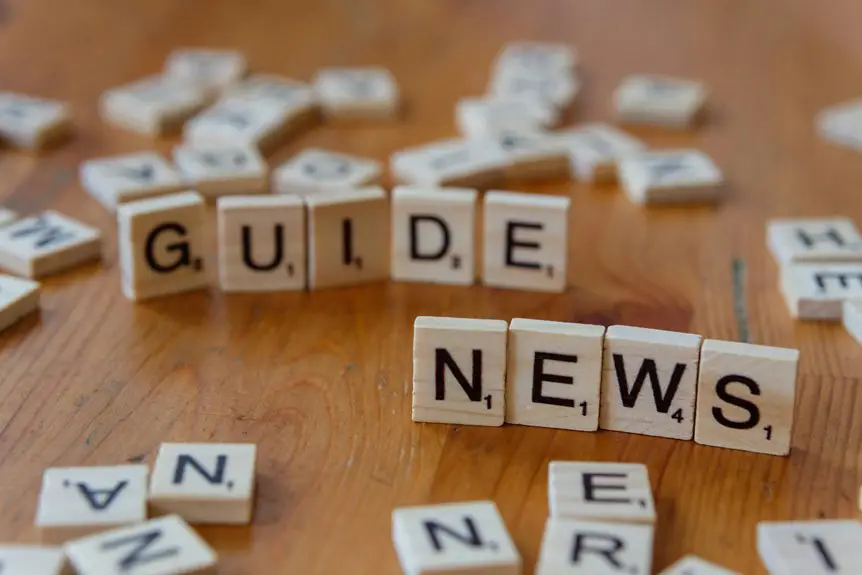To mount a bulletin board, first choose a high-traffic location at eye level. Gather tools like a level, drill, and measuring tape. Mark the wall for accurate placement and prepare the surface by cleaning and checking for repairs. Install the proper mounting hardware, ensuring it's secure. Finally, attach the board and check its stability. Personalize it with borders and clips. You'll find more great tips and ideas to enhance your bulletin board experience.
Table of Contents
Key Takeaways
- Choose a high-traffic area and position the bulletin board at eye level for maximum visibility and accessibility.
- Gather necessary tools such as a level, measuring tape, drill, and appropriate mounting hardware based on wall material.
- Measure and mark the wall for the desired height and center point, ensuring a straight line for accurate installation.
- Install wall anchors securely, drill holes, and align the board with marked areas, using a level for straightness.
- Check stability by gently shaking the board and personalize it with decorations or functional enhancements for improved usability.
Choosing the Right Location for Your Bulletin Board
When you're choosing the right location for your bulletin board, consider where it'll be most effective and visible.
Think about high-traffic areas like hallways, community centers, or kitchens where people gather. You want it in a spot where everyone can easily access it and see the information you'll post.
Avoid placing it in dimly lit corners or behind doors where it'll go unnoticed. Also, consider the height; it should be at eye level for the majority of users.
Ensure it doesn't obstruct walkways or create clutter. Lastly, think about the theme or purpose of your board. A location that aligns with its content will enhance engagement and encourage people to read and contribute.
Gathering the Necessary Tools and Materials
Before you start mounting your bulletin board, it's essential to gather all the necessary tools and materials to ensure a smooth installation process.
First, you'll need a level to keep your board straight, a measuring tape for accurate sizing, and a pencil for marking.
Make sure to have a drill or screwdriver handy, depending on your chosen mounting hardware. You'll also need wall anchors or screws, which should match the weight of your bulletin board.
Finally, gather a stud finder to locate secure spots in your wall if you're mounting on drywall.
Having everything ready will save you time and frustration, allowing you to focus on creating a functional and visually appealing display.
Measuring and Marking for Accurate Placement
Accurate placement is crucial for a well-mounted bulletin board, so start by measuring the desired height and width on your wall. Use a measuring tape to determine where you want the top edge of the board to sit, typically eye level. Once you've chosen the height, mark this point lightly with a pencil.
Next, measure the width to find the center point. If you want the board centered on the wall, measure the wall's total width and divide by two. Mark this point as well.
To ensure everything's level, use a level tool to draw a straight line between your height marks. This line will guide you in securing the bulletin board evenly, creating a polished look.
Preparing the Wall Surface
Before you mount your bulletin board, you need to prepare the wall surface properly.
Start by assessing the wall material to ensure it's suitable for mounting, and then clean the area thoroughly to get rid of any dust or debris.
Finally, determine the optimal height for your board to make it functional and visually appealing.
Assess Wall Material
As you prepare to mount your bulletin board, assessing the wall material is crucial for ensuring a secure installation.
Start by identifying whether your wall is drywall, concrete, or plaster. Each material requires different mounting techniques. For drywall, use anchors or screws designed for the weight of your board.
If your wall is concrete or brick, you'll need masonry screws and a drill with a masonry bit.
Plaster walls can be tricky; use wall anchors to prevent cracking.
Remember to check for any electrical wiring or plumbing behind the wall before drilling. Taking this step helps avoid damage and ensures your bulletin board stays securely in place for years to come.
Make the right choice now to save yourself headaches later!
Clean Surface Thoroughly
A clean wall surface is essential for a successful bulletin board installation. Before you mount your board, take the time to prepare the area properly. Dirt, dust, or residue can prevent adhesive or fasteners from sticking securely, leading to an unstable installation.
Here's how to ensure your wall is ready:
- Dust the Area: Use a soft cloth or microfiber duster to remove dust and cobwebs.
- Wipe with a Damp Cloth: Lightly moisten a cloth and wipe the surface to eliminate grime or stains. Make sure to dry it afterward.
- Check for Repairs: Inspect the wall for any cracks or holes, and patch them up if necessary.
Once the surface is clean and smooth, you're ready to move on to mounting your bulletin board.
Determine Optimal Height
How do you decide the best height for your bulletin board? Start by considering who'll primarily use it. If kids are involved, position it low enough for them to reach easily.
For adults, a height of about 57 to 60 inches from the floor is often ideal, as it aligns with average eye level. Next, think about the space around the board. Ensure there's enough clearance above and below so it doesn't feel cramped.
You might also want to factor in the type of content you'll display. If it's frequently updated, a comfortable height will make it easier for you to pin and remove items.
Lastly, step back and visualize it in the room to ensure it fits harmoniously with your decor.
Installing the Mounting Hardware
Now that you've prepared the wall surface, it's time to install the mounting hardware.
You'll want to select the right hardware for your bulletin board, measure its position accurately, and secure the wall anchors properly.
Following these steps ensures your board stays firmly in place.
Selecting Proper Mounting Hardware
Choosing the right mounting hardware is crucial for securely installing your bulletin board. The type of hardware you select depends on the weight and size of your board, as well as the wall material.
Here are some essential options to consider:
- Wall Anchors: Great for drywall, they provide extra support for heavier boards.
- Screws: Use robust screws that can hold the weight of your bulletin board, ensuring they're compatible with your wall type.
- Adhesive Strips: Ideal for lighter boards, they offer a no-drill solution but make sure they're rated for the load.
Measuring Wall Positioning
Once you've selected the right mounting hardware, it's time to determine the best wall positioning for your bulletin board. Start by choosing a spot that's easily accessible and visible.
Use a measuring tape to find the desired height; generally, eye level is ideal, around 57 to 60 inches from the floor. Mark this height on the wall with a pencil.
Next, measure the width of the board and find the center point on your chosen wall. Measure outwards from the center to ensure your board is centered and level.
Finally, double-check your measurements before proceeding. Making sure your positioning is accurate now will save you time and hassle later when you install the bulletin board.
Installing Wall Anchors Securely
Before you start installing the mounting hardware, it's essential to secure the wall anchors properly to ensure your bulletin board stays in place.
Follow these steps for a reliable installation:
- Choose the right anchors: Select anchors that match the weight of your bulletin board and the type of wall.
- Drill the appropriate holes: Use a drill bit that fits your wall anchors snugly, ensuring a secure fit.
- Insert the anchors: Gently tap the anchors into the holes until they're flush with the wall surface.
Once the anchors are in place, you can proceed to attach the mounting hardware.
This foundation will provide the stability your bulletin board needs, keeping it securely mounted for all your notes and reminders.
Attaching the Bulletin Board
Attaching your bulletin board securely is crucial for both safety and functionality.
Begin by aligning the board with the wall anchors you installed earlier. If your bulletin board has a frame, use a level to ensure it's straight before securing it.
Next, insert screws through the mounting brackets on the back of the board into the wall anchors. Tighten each screw firmly, but be careful not to overtighten, as this can damage the board or wall.
For larger boards, consider having a friend assist you to hold it in place while you secure it.
Once attached, give it a gentle shake to confirm it's stable. Now, your bulletin board is ready for use, providing a reliable space for your notes!
Adding Finishing Touches and Personalization
As you settle your bulletin board into its new home, adding finishing touches and personalizing it can transform a simple board into a reflection of your style and needs.
Consider these ideas to make your bulletin board uniquely yours:
- Colorful Borders: Use washi tape or fabric to create a vibrant border that frames your board.
- Themed Decorations: Incorporate stickers, photos, or drawings that reflect your interests or current season.
- Functional Accessories: Add clips, magnets, or hooks to hold important notes or reminders securely.
These elements won't only enhance the aesthetics of your bulletin board but also turn it into a functional space that inspires and organizes.
Enjoy the process of making it distinctly your own!
Frequently Asked Questions
What Type of Wall Can I Mount My Bulletin Board On?
You can mount your bulletin board on drywall, plaster, or wood surfaces. Avoid mounting it on fragile materials like wallpaper or thin paneling, as they may not support the weight and could damage easily.
Can I Use Adhesive Strips Instead of Hardware for Mounting?
Yes, you can use adhesive strips instead of hardware for mounting. Just make sure the strips can support the board's weight and adhere well to your wall surface. It's a convenient alternative for lightweight boards.
How Do I Remove a Bulletin Board Without Damaging the Wall?
To remove a bulletin board without damaging the wall, gently pull it away from the surface. If it's stuck, use a hairdryer to soften any adhesive, then carefully peel it off. Clean any residue afterward.
What Are the Best Materials for Outdoor Bulletin Boards?
For outdoor bulletin boards, you'll want weather-resistant materials like aluminum, plastic, or treated wood. Using a weatherproof backer and UV-resistant coatings will help ensure your board lasts against the elements while maintaining its appearance.
How Can I Ensure My Bulletin Board Is Level After Installation?
To ensure your bulletin board's level after installation, use a spirit level during the process. Adjust it as needed, checking frequently. Once it's straight, secure it firmly to maintain that perfect alignment.




